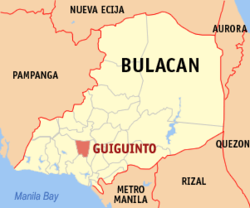Guiguinto, Bulacan
| Guiguinto | ||
|---|---|---|
| Municipality | ||

Guiguinto Municipal Hall
|
||
|
||
| Nickname(s): The Garden Haven Of Bulacan; Garden City | ||
| Motto: Guiguinto, Patuloy Sa Pag-Unlad. Guiguinteño Angat Ka Sa Lahat. | ||
 Map of Bulacan showing the location of Guiguinto |
||
| Location within the Philippines | ||
| Coordinates: 14°50′N 120°53′E / 14.83°N 120.88°ECoordinates: 14°50′N 120°53′E / 14.83°N 120.88°E | ||
| Country | Philippines | |
| Region | Central Luzon (Region III) | |
| Province | Bulacan | |
| District | 2nd District | |
| Founded | 1641 | |
| Barangays | 14 | |
| Government | ||
| • Mayor | Ambrosio Cruz Jr. | |
| Area | ||
| • Total | 27.50 km2 (10.62 sq mi) | |
| Population (2015 census) | ||
| • Total | 99,730 | |
| • Density | 3,600/km2 (9,400/sq mi) | |
| • Poverty rate |
|
|
| Time zone | PST (UTC+8) | |
| ZIP code | 3015 | |
| IDD : area code | +63 (0)44 | |
| Income class | 1st Class | |
| Electricity | Manila Electric Company | |
| • Consumption | 56.94 million kWh (2003) | |
| Website | guiguinto |
|
Guiguinto is a first class urban municipality in the province of Bulacan, Philippines. According to the 2015 census, it has a population of 99,730 people.
Guiguinto is one of the fast-growing municipalities. From a predominating agricultural economy, it gradually urbanized and developed, now part of the Metro Manila conurbation.
It is the birthplace of composer Constancio De Guzman, known for writing songs like "Maalaala Mo Kaya". It also houses the Immaculate Conception Seminary, a Diocesan Seminary of the Diocese of Malolos located in barangay Tabe. The appellation “Guiguinto” literally translates to “Gold” for the early conquistadores came and saw this town on a harvest season when it lushes in golden rice stalks against the sun.
Guiguinto began as a barrio of Bulakan, the former provincial capital of Bulacan. It is said that Spaniards set up an army post in the barrio to serve as a resting place for forces going to Northern Luzon. In those days, travel throughout Guiguinto was difficult and slow down to cross single file over a narrow bamboo bridge. Their Filipino guides would cry out, "Hinto" (stop). The Spaniards thought this was the name "Hihinto". The Spaniards substituted "Gui" (with hard "g") for the Tagalog "Hi". The place has since been called Guiguinto. On the other hand, old timers say that on moonlight nights, a golden bull emerges from the church and goes down to the nearby river to quench his thirst. It then returns to the church, ascends at the altar and disappears. The elders' aid that there are buried jars of gold in town, as indicated by the bull, and that is why the town was called Guiguinto. It became an encomienda in the 1591 but the ecclesiastical administration was under Bulakan Convent and it was established as a Town in 1641.
In 1800, an Augustinian friar erected a small chapel in what is now barrio Sta. Rita. In 1873, roads were constructed in barrio Malis. The people barrios of Pritil, Tabe, and Cutcut even those days were mostly farmers. During Holy Week, villagers of barrio Tuktukan held contest for the hardest egg shells (chicken, duck or goose by knocking eggs together (Tuktukan)). The women tried to help each other in singing the "Panica".
...
Wikipedia


